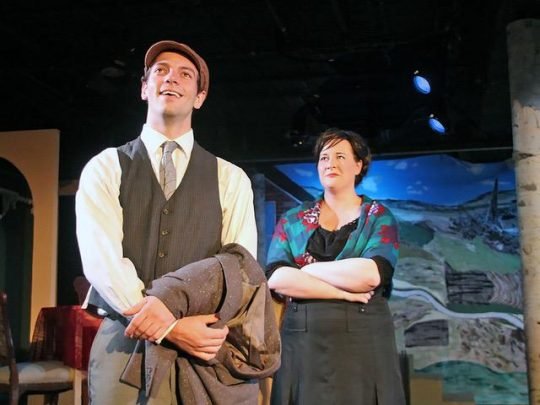
2 1/2 stars
It’s true that the very best writers use experiences from their own lives to inspire their writing. English author D.H. Lawrence, whose early twentieth century novels like Lady Chatterley’s Lover, Women in Love, Mr. Noon and The Rainbow shocked and entertained readers during this “Age of Innocence.” It’s also true that his stories are all very intimately bound up with his own life. But none of his novels is more autobiographical than Sons and Lovers.
This is Lawrence writing about his life and recreating scenes from his own experience, but fictionalizing it. He began writing the book in 1910, finishing the novel two years later.
The story underwent lots of revisions, including the title, and was influenced by many personal crises that occurred during this period. Lawrence ended a long relationship with Jesse Chambers (who’d serve as the model for his character, Miriam Leivers).
He became engaged to, and then broke up with Louie Burrows (who would be the inspiration for the character of Clara Dawes). He lost his mother to cancer, became seriously ill with pneumonia, gave up teaching and moved away from his birthplace. But this is a story that’s derived from the author’s own Oedipus complex.
When Lydia was a young woman, she lost her first love to another woman. She settled for Walter Morel, a boorish, yet passionate lower class man who worked long hours down in the Midland mines.
As sons William and Paul grew up, Lydia doted on them to the point where Walter is brow-beaten and practically ignored and she redirects all of her ardor and passion to her sons. They, in turn, become her lovers and as they grow to manhood they aren’t able to love any other women because their mother’s hold over them is so strong.
Created in 2003, by Mike Brayndick who founded the On The Spot Theatre Company to “develop and stage new plays for performance,” this adaptation of D.H. Lawrence’s autobiographical novel toured England. The U.S. premiere of the play is now being co-presented by the Greenhouse Theater Center.
At almost two-and-a-half hours, Brayndick’s drama closely follows Lawrence’s book. It leaves out very little which is both a strength and a weakness of this script. The production feels choppy. It’s episodic, much like the novel, but as a play, it just doesn’t flow smoothly.
A decision to include songs and a dance while attempting to lighten the drama seems superfluous and only serves to slow the momentum of the story.
Scenes should flow from one to another rather than stopping the action, lowering the lights and waiting for an actor to emerge. The energy level dies when this happens.
Quite possibly, allowing another director who’s not as close to the script’s creation to guide the production, would help immeasurably. While wearing the hat of the director, it’s impossible to separate the playwright from his creation.
Other problems are technical. Saddled with the Greenhouse Theater’s tiny studio venue, Pat Henderson attempts to modestly recreate every locale in the book/play with her sprawling scenic design. Kudos to turning an obtrusive, structural pillar into a tasteful tree trunk, while peppering her set with similar fauna.
A better design choice might’ve been to let the story continuously flow upon a nearly-empty stage, possibly framed by an evocative backdrop, and only utilizing a few, simple, multipurpose set pieces.
Michele Brayndick’s costumes make an admirable attempt at reflecting the drama’s class, period and place. She’s best with the men’s wardrobe, although some pieces could be better tailored. But when, amidst a palette of grays and browns, a blinding pink skirt or a 1960’s blue taffeta prom dress suddenly appears onstage, it jolts the audience out of the story.
Dressing her cast in simpler costumes, while adding an accessory here and there to indicate a character change, would be economical and work just as well.
There are also difficulties with Tyler King’s lighting. While often his illumination helps create the story’s moodiness, sometimes a character will stand in complete shadow, like Brian Boller’s eloquent narrator, D.H. Lawrence.
The cast, many of whom play multiple roles, is adequate. In addition to Miles Borchard’s handsome and earnest portrayal of the exasperating Paul Morel, Amy Gray stands out as Lydia, the strongly-opinionated, influential matriarch of the Morel family.
Emma Brayndick creates a multilayered, intoxicating Clara Dawes; Corrie Riedl, who sports a lovely singing voice, plays a sympathetic, yet intellectually spunky Miriam Leivers; and Stephen Dunn makes the most of Walter Morel, a one-note character who struggles through his abusiveness to show affection to his wife and sons, while slaving away in the mines.
D.H. Lawrence’s autobiographical novel seems ripe for a theatrical dramatization. It’s already been adapted into a successful 1960’s film and there are two stylish BBC television serializations available on DVD.
It must be remembered, however, that although related, a play is a different medium. Mike Brayndick’s production might’ve been more effective and powerful if he’d remembered that less is often more.
Some of the incidents in this 400+ page novel could easily have been omitted. A more objective, seasoned director could bring a fresh view to this play. He could visualize the problems and work with the playwright to smooth the flow of this drama.
Also, if the staging was kept simpler, along with a more Spartan scenic design and costuming, the overall effect might be stronger. As the production currently plays out, this adaptation of D.H. Lawrence’s novel feels like a promising work in progress.
DETAILS: “Sons and Lovers,” an On The Spot Theatre Company production,is at The Greenhouse Theater Center, 2257 N. Lincoln Ave., Chicago, through Sept. 29, 2019. Running time: about 2 hrs, 30 min. For tickets and other information call (773) 404-7336 or visit Greenhouse Theater.
Colin Douglas
For more shows visit Theatre in Chicago
